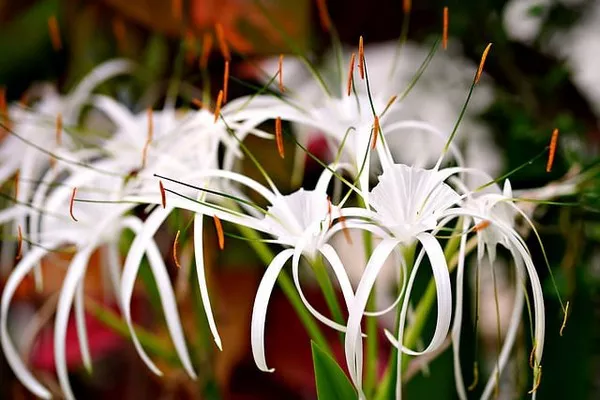The Flowers have long captivated the human imagination with their vibrant colors, delicate petals, and intoxicating scents. Beyond their aesthetic appeal, flowers also carry a rich tapestry of symbolism and meaning, often varying based on their hue. White flowers, in particular, possess a profound significance that spans cultures, religions, and historical contexts. In this exploration, we delve into the multifaceted meanings associated with white flowers, uncovering the emotional, cultural, and spiritual layers that make these blooms an enduring symbol of purity, innocence, and transcendence.
A Blank Canvas of Purity and Innocence:
At the forefront of the symbolism of white flowers lies the notion of purity and innocence. The pristine and unblemished nature of the color white evokes a sense of cleanliness and virtue. White flowers are frequently associated with new beginnings, much like a blank canvas awaiting the artist’s touch. In many cultures, white is worn at weddings, symbolizing the purity and innocence of the union, and white flowers often play a central role in these joyous celebrations.
Cultural Significance and Traditions:
The significance of white flowers extends across different cultures and traditions. In Western cultures, white lilies are commonly associated with funerals and are often used to convey sympathy and the hope for the departed’s peaceful rest. The white lily’s elegance and purity provide a comforting presence during times of grief and mourning.
In Eastern cultures, such as Japan, white flowers, particularly cherry blossoms and chrysanthemums, hold a distinct place in the collective consciousness. Cherry blossoms, known as “sakura,” symbolize the fleeting nature of life and the beauty of transience. Meanwhile, chrysanthemums represent longevity and endurance and are often seen as a symbol of the imperial family.
Spiritual and Religious Connotations:
White flowers are deeply intertwined with spirituality and religion. In Christianity, white flowers are often associated with divinity, resurrection, and the Virgin Mary. The lily, in particular, is a symbol of the Annunciation, signifying the purity and humility of Mary. It is also a recurring motif in depictions of angels, connecting it to celestial beings and spiritual realms.
In Hinduism, white flowers are offered as a gesture of purity and devotion to various deities. They are used in religious rituals and ceremonies as a symbol of the soul’s journey towards enlightenment. White lotus flowers, in particular, hold immense spiritual significance and are often associated with the concept of purity arising from the depths of muddy waters, paralleling the human journey towards enlightenment.
Healing and Renewal:
The symbolism of white flowers transcends the spiritual and enters the realm of healing and renewal. White flowers, such as the magnolia and jasmine, are known for their therapeutic qualities. The delicate aroma of these blooms is believed to have a calming effect on the mind and spirit, providing solace in times of stress or anxiety. The white flower’s association with purity and freshness also aligns with the idea of renewal and rejuvenation, making it a popular choice in aromatherapy and holistic practices.
Love and Reverence:
White flowers possess a unique way of conveying emotions, even in matters of love and romance. While red roses have long been synonymous with passion and romantic love, white roses carry their own tender message. White roses represent a love that is pure, innocent, and untainted by ulterior motives. They signify a deep reverence and admiration for someone, embodying a sense of loyalty and respect that goes beyond fleeting infatuation.
Transcendence and Illumination:
The luminous quality of white flowers also points towards a sense of transcendence and illumination. Just as light pierces through darkness, white flowers symbolize the triumph of light over darkness, truth over ignorance, and enlightenment over confusion. This symbolism is particularly poignant in spiritual practices and meditative contexts, where white flowers can serve as a focal point for contemplation and inner awakening.
Cultivating White Flowers in the Modern Age:
As we navigate the complexities of the modern world, the significance of white flowers remains as relevant as ever. In an era marked by rapid technological advancements and constant sensory stimulation, the understated elegance of white blooms offers a moment of respite and reflection. Cultivating white flowers, whether in personal gardens, public spaces, or indoor settings, can serve as a reminder of the timeless virtues of purity, innocence, and serenity.
Furthermore, the versatility of white flowers allows them to be seamlessly integrated into a variety of occasions and settings. From weddings and funerals to religious ceremonies and everyday moments of introspection, white flowers continue to convey profound meanings that resonate across cultures and generations.
In Conclusion:
The symbolism of white flowers is a tapestry woven with threads of purity, innocence, spirituality, and renewal. These blooms carry a universal language that transcends linguistic barriers, speaking directly to the human heart and spirit. Whether offered as a gesture of sympathy, worn on a joyous occasion, or used as a tool for meditation, white flowers hold a space for introspection and contemplation in a world often bustling with noise and distraction. As we appreciate the elegance and beauty of white flowers, we are reminded of the enduring power of nature’s symbols to connect us to the deeper facets of our existence.


